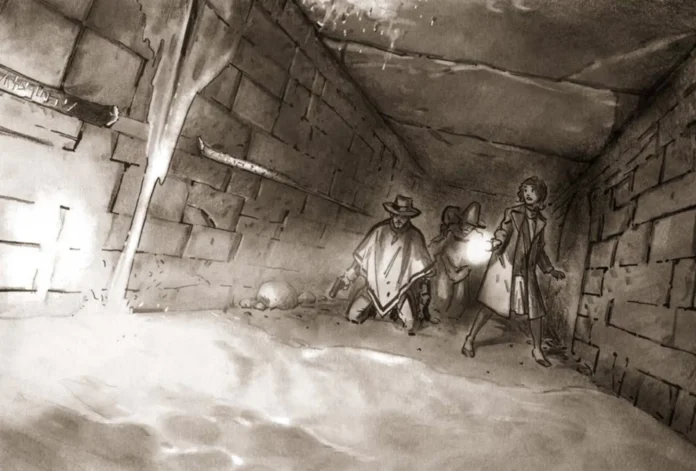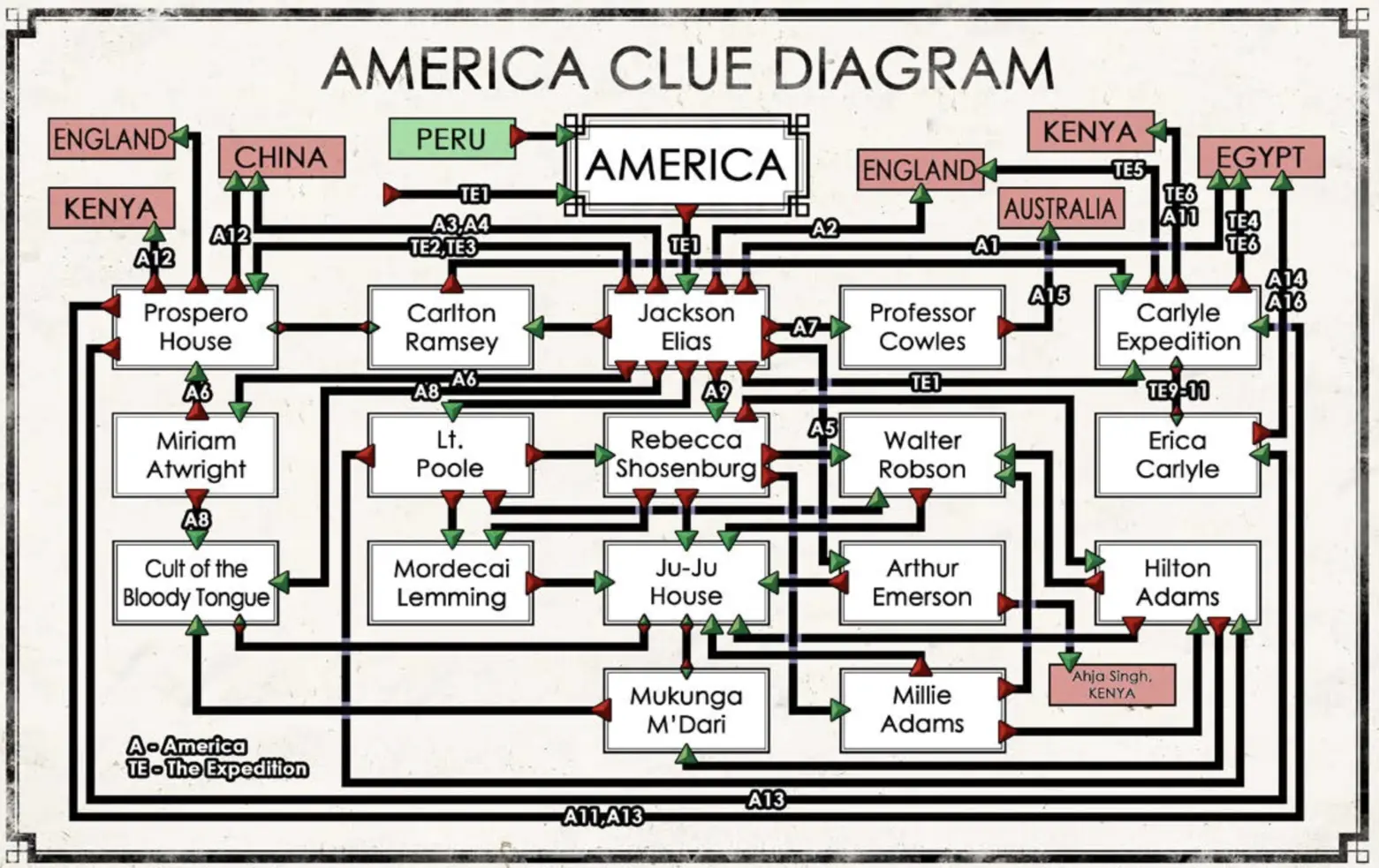Continuing our series on some of the most well known published RPG campaigns, we move on to Call of Cthulhu’s Masks of Nyarlathotep (MoN), another venerable published campaign.
First published in 1984 as a five book boxed set, it has seen frequent reprints and updates as Call of Cthulhu moved through its editions over the years, largely unchanged but for the addition of a chapter added to the version published for 5th edition Call of Cthulhu in 1996.
The most recent edition, fifth, was updated and released in 2018 for use with Call of Cthulhu 7th edition, and saw the addition of a prologue chapter, as well as guidance for running the campaign in “purist” mode (which is to say, with the core rules as written) or with the Pulp Cthulhu supplement. It’s this edition we’ll focus on.
The campaign has received widespread critical acclaim over the years, and its general popularity, coupled with the length of its publication history, has resulted in there being a considerable amount of fan resources available for it online.
As always, current or prospective players of this campaign, begone lest you encounter spoilers.
MoN is a 1920s adventure in which the characters stumble upon the machinations of a global conspiracy of interconnected cults working together on a plot that puts the world itself in danger. With ingenuity, intelligence, the characters must place their lives and minds in danger in the attempt to thwart these schemes and protect the world from malevolent forces.
The book opens with a summary of the background plot, and a timeline of key events rather than them being spread haphazardly around the book, which is a trap far too many older campaigns have fallen into.
The plot stretches over several countries: Peru (a newly introduced prologue chapter in the fifth edition), America, England, Egypt, Kenya, Australia, and China. Doing some research into these countries at the time comes recommended, though the campaign starts each country’s chapter with some useful general information, so you aren’t completely in the dark. Specific flavour and detail for each chapter’s locale can only help verisimilitude, though equally you shouldn’t be fettered by reality where a change will only improve play.
Each locale has its own cult in residence, and their motivations, stated goals, and histories are detailed in the background information section of each chapter as well.
Besides from the more linear Peru, the campaign is a fairly open-ended sandbox in its structure: characters can pursue the locales in any order they desire with the information that they uncover. That said, I’d argue that there’s enough textual support to recommend an intended order, and some countries and their associated plot lines would more obviously suit as a climax to the campaign.
While I’d personally recommend keeping it in place as it is, since organic gameplay is always appreciated, you can conceivably direct the players down your own preferred pathway by limiting and moving around the clues; the opening chapter in America after the prologue essentially hands the characters a bag of clues providing links to all of the available locales in the campaign, so this can be changed to suit your preferred pathway. A common preference is to move around clues pointing to China to other locales, helping to ensure the climax occurs at that location, as it’s one of the most narratively obvious dramatic conclusions to the whole campaign.
On the subject of the clues, there’s a refinement to this edition of the campaign that makes life easier; each chapter opens with a diagram of that chapter’s clues, how they interlink, and where they lead, which is a phenomenally helpful quick reference (see below for an example).
As with any campaign of this nature, go in with the right expectations: read it over, commit as much to memory as you can, and talk to your players about whether or not it’s the kind of thing they’d enjoy playing, as well as understanding this is likely to be a time commitment of a year… and probably more. It’s a long campaign.
There’s a handy section right near the start of the book detailing what kind of character concepts work and a list of skills that’ll be relevant in the campaign, along with several pregenerated characters that can also serve as guidance. The recommended skills list in particular is a wonderful way to prepare some expectations for the story without spoiling any specific details. And if you’re running this game with Purist rules, this campaign has a bit of a reputation as a meat grinder for a reason; warn your players about the high lethality and very real possibility their character will die, as well as consider by yourself how you might introduce back up characters in a natural way.
There is one thing, however, that I dislike in this edition: the Pulp alternatives given for encounters and most of the enemies. Outside of a handful of NPCs — namely the cult leaders and one or two others — I don’t see the need to beef up everything the players face, it seems to me you’re losing most of what characterises a game as Pulp by doing so. Surely the point of Pulp characters is that they’re capable, tough individuals, able to take on challenges and stand toe to toe with the average cultist with no trouble? This isn’t an argument against running the game with Pulp rules — in fact, having run it both Purist and Pulp, I’d say Pulp fits the campaign better and gives you that much more chance to keep characters alive — but if you do, just use the Purist stats and encounters in most cases.
The latest edition of the campaign is written well, and the amount of background information and supplementary information provided to you as Keeper was helpful to me. I’ve seen some people express doubts about the quality of the Peru chapter added for this addition, though for my own part I think it works well.
That said, you can replace it with something else that serves the same narrative purpose with a bit of work, since the purpose of the Peru chapter is more to serve as the introduction of an NPC that the characters are supposed to forge a friendship with, who serves as the central framing device for why the characters are involved in the campaign. A popular and not too broad in scope introductory scenario like The Haunting could work.
Keepers might also be interested in looking up the fan-made scenario (available at DrivethruRPG, Swamp Song, which can serve as suitable connective tissue between the prologue chapter and the America chapter.
Masks of Nyarlathotep is a well regarded campaign for good reason, though like any published campaign, you’re still going to have to put work into it, particularly if you revise or re-write any parts of it. But, in my experience, it was rewarding to run, and the different groups I’ve run it for had fun with it. I’m hoping to run it at least once more, in fact.
Masks of Nyarlathotep is available in PDF form at Drivethrurpg.com for £47, or available in full colour hardback print for the admittedly rather eye watering cost of £108 from Amazon, though can likely be found for cheaper if you shop around. You could pick up an earlier edition for a considerable reduction in price, but the quality and refinement of the most recent edition is heads and shoulders over what came before.
Highly recommended to any Call of Cthulhu Keeper in the slim to no chance event that they haven’t already heard of it.

| [donate]
| Help keep news FREE for our readersSupporting your local community newspaper/online news outlet is crucial now more than ever. If you believe in independent journalism,then consider making a valuable contribution by making a one-time or monthly donation. We operate in rural areas where providing unbiased news can be challenging. |

















